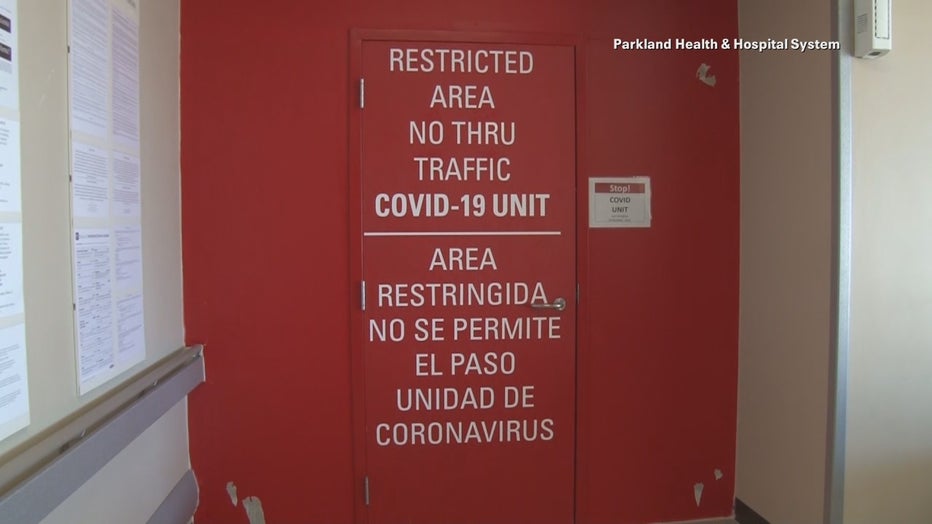COVID-19 hospitalizations across North Texas region reach 13.96 percent
DALLAS - COVID-19 hospitalizations are now near 14% of all hospitalizations for the North Texas region.
It's just a little more than one percentage point away from the threshold to trigger rollbacks, according to the governor’s rules.
The percentage in our trauma region is 13.96. It must be 15% for seven straight days before bars close and capacity in restaurants and retail drop.
Of the four area counties with the highest populations, Tarrant county reported a new record in hospitalizations. Dallas County reported fewer hospitalizations but 17 deaths on Wednesday.
Experts fear these numbers will only get worse.
Local leaders are calling on the governor to take action. Gov. Greg Abbott is set to speak publically Thursday for the first time this week.
Newly-released video from Parkland Memorial Hospital shows healthcare workers as they tackle North Texas’ biggest spike in cases yet.

More patients are hospitalized with COVD-19 now in the DFW Metroplex than ever before. Healthcare systems, like Parkland, still have capacity left and even showed us places like an operating room that could house two COVID patients if needed.
Floynetia is thankful she did not have to be hospitalized. She asked that FOX 4 not use her last name.
“It’s just through the grace of God I can sit here and talk to you about it,” she said.
Floynetia went to the Parkland ER Sunday and tested positive. It’s a concern since she’s waiting for a kidney transplant.
“I didn’t feel well,” she said. “I started having body aches, and I mean my whole body was hurting. I thought it was from dialysis.”
Floynetia says she's past the worst of it and is quarantining at home. She says she did her best to avoid getting sick and wants others to take it seriously.
“This is not a game,” she warned. “Whether it’s minor, major, it’s here.”
COVID hospitalizations dropped slightly Wednesday in Dallas County, but the county also reported 17 deaths.
Hospitalizations rose to a new high in Tarrant County with now nearly 800 patients. The percentage of ventilators in use there is at its highest level since late July.
Cook Children’s in Fort Worth reported 20 patients, its highest number of COVID patients yet. Hospital officials are not worried about capacity but will likely need to allocate more space to treat COVID patients.
“We are probably going to need another floor unit to take care of COVID patients over the next few days or next week,” said Dr. Suzanne Whitworth with Cook Children’s. “So we look at which units we can do that with airflow and staffing and other things.”
Dr. Rajesh Nandy specializes in biostatistics and public health at the UNT Health Science Center. If trends continue, he projects North Texas hospitals could reach capacity in the next two to three weeks. At that point, more people are at risk of dying.
“An even bigger concern is that the case-fatality rate can inch up when the hospitals reach their max capacity because at that point they may not be able to provide the best care needed for patients,” Dr. Nandy said.
Meanwhile, Gov. Abbott on Thursday will hold his first news conference on the virus in weeks. The topic will be the distribution of a therapeutic drug. The governor told conservative radio host Mark Davis on 660 AM last week there will not be more lockdowns.
Dallas Mayor Eric Johnson planned to speak with the governor Wednesday.
“My understanding is the governor has essentially said we’re not going back on lockdown. I believe he’s said that publicly. I’m a practical person. My job to the extent I can is to try to save people’s lives so I’m going to share with the governor everything I’ve heard from our healthcare community,” the mayor said. “But we need to be realistic and take into our own hands our safety and understand that if that’s not coming, that just means it’s more important to control the things that are within our control.”
Dr. Nandy says there's some hope all the warnings from public health officials over the past couple weeks will lead to people taking more precautions.
We would likely see that in data in the next week or two. If there's no slowing, he says more aggressive measures would need to be considered.

